The Top 7 Small Things That Have Made My Day to Day Disaster Recovery Easier (and a BIG Bonus Item!)
Just trying to make it through each day of disaster recovery is a challenge in itself. The struggle is real! Life didn’t suddenly stop after Hurricane Michael ripped through my town. If anything, it simply shifted gears, but I still had to do all of the basics like eating. After all, you’re not going to get very far during the day if you haven’t. So, if you’re searching for something, anything, that just might make your day a tiny bit easier, you may find something on this list is the solution to your problem or the inspiration you need to find your own!

First things first: I hate how lists like this can often make you feel like you HAVE to have x, y, and z to achieve something you want. This is just a list of items I have personally found tremendously helpful in getting through another day that may work for you too! Living in a heavily damaged home presents some unique challenges. So, let’s be clear, you should use this as a guide of disaster recovery solutions to find ways to solve problems you’re having and make your day to day easier.
1. My Clip-On Rechargeable Reading Lamp
Because of the way my house is structured, much of the rain that poured into my home bypassed the second floor and went straight to the first. It damaged all of the ceilings downstairs and many of the overhead lights. The fixtures that did survive had to come down in the tear out. A lot of my furniture was also either destroyed or had to be moved. Some of the outlets aren’t even safe to use now.
So, lamps weren’t always an option. For well over a year, I struggled to do anything that required reading after the sun went down. I went so far as to schedule things like studying or reading through the growing stack of important papers to daylight hours before work and on my lunch break. Worse still, I was frequently behind on tasks like looking over the 200+ page reports from the various insurance adjusters. This only added to my stress and frustration.
When I won a small gift card to Amazon from a trivia challenge at school, I wanted to be sure to put it to good use for something that could help make my classes easier. A little light bulb went off! All puns aside, I realized that something as simple as a small clip-on reading light would be a huge help!
I found this one that was light enough to be comfortable, offers three levels of brightness, and is perfectly flexible. It’s even rechargeable! After all, I’ve spent so much on batteries already. It stays clipped to my lap desk for an instant, portable mini workspace. I can now get so much more done!
2. My Plug-in Pendant Lamps
I had two of the awesome Ikea Stråla floor lamps in my dining room before the storm. Their star-shaped paper shades were among the earliest casualties when the large bank of windows next to them burst in. Thankfully, the bases themselves still worked. They quickly became make-do lighting with one in the kitchen next to the sink. Still, this left the remaining counters in the dark. It was miserable to try to cook after work, not to mention dangerous!
My SO was in town one evening and suggested the brilliant, simple idea to use a plug-in pendant lamp overhead. Why the hell didn’t I think of this before?! I even had some from Ikea packed away from a pre-storm DIY project.
I ran upstairs, dug one out, and we hoisted it over the wiring in the now exposed rafters. Let there be light! It’s not the ideal task lighting, but it certainly works for now. I added a plug-in dimmer switch so I can easily turn it on and off when I need it as well.
3. Visqueen…Visqueen Everywhere!
Many of the downstairs windows are now just empty holes. A number of the walls have been torn out as well for mold damage, including the insulation. In 1935, they didn’t build houses here with wood sheathing. My siding is nailed straight to the outside of the studs and the wall material to the inside. Between flying debris, windows that blew in framing and all, and two chimneys that pulled away from the house, I no longer have much in the way of siding. I have Swiss cheese.
No need to open a window for fresh air, there’s already a breeze coming through the house. Sometimes, it’s an actual wind.
My tear-out was done two months after the storm…in December. We were having one of the coldest winters in recent memory and something had to be done to at least make it bearable inside. I considered tacking up moving blankets (thick and cheap) or picking up a bunch of comforters and blankets from Goodwill (cheaper still, but they’d have to be washed to get rid of the thrift store smell and I no longer have a laundry set up), but both of these options would also harbor mold.
Visqueen to the rescue! This thin, plastic sheeting is inexpensive, comes in large rolls that cover some serious square footage, and it’s waterproof. This is particularly handy when it’s still raining inside your house. I tacked it to the studs with a staple gun. However, I soon realized I needed to add a run of furring strips screwed in along the top so it would hold up to the wind. The visqueen is quite noisy on a windy day and my utility bills are still through the roof, literally, but it has cut down on the breeze.

4. Reusable Pet Pads
The rain inside isn’t like a common roof leak. It doesn’t come down in a single spot for a bucket to easily catch. Also, buckets of rain water are apparently fascinating toys for kitties. This quickly renders the buckets pointless when my girls tip them over and it spills across the floor anyhow.
Instead, it comes down in long lines mirroring the shape of my dormers upstairs that pulled away from the roof when the house twisted in the storm. So, I repurposed pet pads I keep around for the litter boxes and carriers to catch the rain and prevent further damage. This was getting expensive as time dragged on and the environmental impact was terrible.
Luckily, I found these large reusable and washable pads to use instead! Here’s a quick tip if you need to use them in an area where you walk: Be sure and put some rug grippers underneath. Or, you’re likely to find out how that cartoon character feels when stepping on a banana peel!
5. Air Quality Appliances – Essential Disaster Recovery Solutions
Perhaps the most important on the list, these appliances need the least explanation. Lack of walls, ceilings, and windows plus high Florida humidity and a loss of trees to clean the air equals harmful air quality, respiratory issues, headaches, and more mold. The mitigation crew did an excellent job removing the mold covered surfaces. However, the spores were still lurking in the air and bloomed with the humidity seeping in.
My large capacity dehumidifier and air purifiers have helped keep the main spaces a little more tolerable. Also, I highly recommend air purifiers for those of you in wildfire territory as well. They make a noticeable difference when our pine forests are ablaze.
6. More Digital Assistants
Let’s be honest, I’m leery of digital assistants, but there’s an awful lot of things to keep up with these days! I’ve added two more to keep me on track, but you can read more on how handy these devices are for disaster recovery here.
7. A Stack of Personal Growth Books
Disaster recovery is not only physically draining, but it’s emotionally draining, too. Having these helps me recharge. You can find some of my suggestions here.
These are the top 7 small things that have made my day to day a little more bearable over the last three years while waiting to be able to rebuild my home. I hope they’ve sparked some ideas for how you can, too!
But wait! There’s more!
*The BIG Bonus Item*
Making things work well enough to stay in my house has certainly meant astronomical utility bills. Still, it was less expensive than paying both a mortgage and insurance for a house I wouldn’t be using AND rent on an apartment; IF I could have found one. There was little usable housing here after the storm and too many people needed a place to go. The remaining hotels were also full. RVs were sold out. Rental prices skyrocketed 50-300%.
If you have insurance, this can be covered by the part of your policy frequently referred to as Additional Living Expense (ALE). Yet, this tends to be limited to a small percentage of your total policy coverage (typically 10%) and, even then, you may have to fight to get it…eventually.
I realized this would only cover a few months of the higher rent anyhow and knew there was a good chance it wouldn’t be long enough for reaching a settlement. Not to mention waiting for a spot in a contractor’s schedule. Besides, there were too many other people whose homes no longer existed at all and had suddenly become homeless living in tent farms set up by various kind souls. To add insult to injury, houses that are left empty while waiting for repairs are often targeted by squatters and meth addicts that have robbed and vandalized them; including another property I own with my brother.
So, when I finally reached a settlement with my insurance, including the ALE, the most logical option for me was to buy a small travel trailer. I had plenty of time to research and decided to go with the Coleman Lantern 17B. It’s tiny, but cozy. It sleeps up to six, has a bathroom, an air conditioner, and even an electric fireplace. Most importantly, it was both in my budget and light enough for me to easily pull with my Pathfinder.
This will not only allow me to stay on site during the rebuild, but also to evacuate the next time a storm heads our way more quickly and easily. I won’t have to worry about finding or paying for a hotel or whether or not pets are welcome. I can just load up a few last minute items, grab the kitties, back up my SUV, and go.
I’ll be sure to share even more useful goodies for disaster recovery solutions soon, but please add anything that has made your day to day more manageable below!
*Please note: The provided links are not currently affiliate links and I do not receive any compensation for purchases of these products. I will update this notice if/ when they are. However, I have personally tested and recommend each item on this list.





